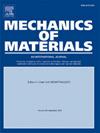Estimation of representative length-scales for heterogeneous brittle materials subjected to high-strain-rate loading
IF 3.4
3区 材料科学
Q2 MATERIALS SCIENCE, MULTIDISCIPLINARY
引用次数: 0
Abstract
Continuum-scale modeling of dynamic compressive failure of brittle materials has several important applications such as the design of protective structures under impact loading. These materials can often be highly heterogeneous due to the presence of several cracks or other crack-nucleating defects. Since cracking is a dominant failure mechanism in such problems, material heterogeneity (‘microstructure’) also evolves dynamically as a large number of cracks grow in the material. This necessitates a dynamic damage modeling approach since modeling individual cracks explicitly is cost-prohibitive. When mesh-based computational techniques are utilized for such problems, often a need for fine mesh resolution arises to generate high-fidelity results. Most often mesh sensitivity studies focus on optimizing the mesh size for computational cost, and assume that the constitutive formulation itself remains scale-free. In this work, we propose a procedure to establish a ‘representative length-scale’ for dynamically loaded heterogeneous materials, above which the material can be described by an appropriate local constitutive formulation for the purpose of predicting the response during dynamic failure. Microstructural evolution due to cracking is modeled using synthetic microstructures representing the cracking process assuming a Poisson Point process of pre-existing defect centers. A modulus-increment-based criterion is proposed for representative length-scale determination where the change of material modulus as damage progresses is compared across non-local and local constitutive response. The effect of rate of loading on the predicted RL is also quantified. A demonstration of the defect point process determination procedure in the case of a specific advanced engineering ceramic, boron carbide, is also provided.
高应变率加载下非均质脆性材料代表性长度尺度的估计
脆性材料动态压缩破坏的连续尺度建模在冲击载荷下防护结构的设计等方面具有重要的应用。由于存在几个裂纹或其他裂纹成核缺陷,这些材料通常是高度不均匀的。由于裂纹是此类问题的主要破坏机制,材料的非均质性(“微观结构”)也随着材料中大量裂纹的增长而动态演变。这就需要一种动态损伤建模方法,因为明确地对单个裂纹进行建模成本过高。当基于网格的计算技术被用于此类问题时,通常需要精细的网格分辨率来生成高保真的结果。通常,网格敏感性研究的重点是优化计算成本的网格尺寸,并假设本构公式本身保持无标度。在这项工作中,我们提出了一个程序来建立一个“代表性长度尺度”的动态加载的非均质材料,以上材料可以用一个适当的局部本构公式来描述,目的是预测动态破坏期间的响应。由于裂纹引起的微观组织演变是用合成的微观结构来模拟的,假设预先存在缺陷中心的泊松点过程。提出了一种基于模量增量的具有代表性的长度尺度确定准则,通过非局部和局部本构响应比较材料模量随损伤进展的变化。加载速率对预测RL的影响也进行了量化。并以一种特殊的高级工程陶瓷——碳化硼为例,给出了缺陷点工艺确定程序的演示。
本文章由计算机程序翻译,如有差异,请以英文原文为准。
求助全文
约1分钟内获得全文
求助全文
来源期刊

Mechanics of Materials
工程技术-材料科学:综合
CiteScore
7.60
自引率
5.10%
发文量
243
审稿时长
46 days
期刊介绍:
Mechanics of Materials is a forum for original scientific research on the flow, fracture, and general constitutive behavior of geophysical, geotechnical and technological materials, with balanced coverage of advanced technological and natural materials, with balanced coverage of theoretical, experimental, and field investigations. Of special concern are macroscopic predictions based on microscopic models, identification of microscopic structures from limited overall macroscopic data, experimental and field results that lead to fundamental understanding of the behavior of materials, and coordinated experimental and analytical investigations that culminate in theories with predictive quality.
 求助内容:
求助内容: 应助结果提醒方式:
应助结果提醒方式:


